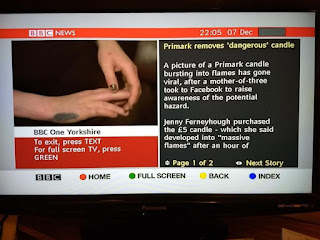John 1.1-16
A few weeks ago my daughter went out and bought a Christmas candle. That night she decided to light it. Everything was fine until, after an hour, the whole thing suddenly burst into flame.
Fortunately my daughter was in the room, the candle was extinguished and no harm was done. But then she took a fateful decision. She decided to put a post on Facebook warning her friends about the candle and asking them to pass on the news about its dangers.
Within a few hours the post had gone viral and within a couple of days it had been shared more than 300,000 times. Journalists began ringing the house. The story appeared on lots of local  newspaper websites around the country, on the BBC website, and on The Sun and The Daily Mail websites. My brother-in-law even rang to tell us it was on Teletext. I didn't know that Teletext still existed! TV crews asked to visit the house, but my daughter politely declined.
newspaper websites around the country, on the BBC website, and on The Sun and The Daily Mail websites. My brother-in-law even rang to tell us it was on Teletext. I didn't know that Teletext still existed! TV crews asked to visit the house, but my daughter politely declined.
 newspaper websites around the country, on the BBC website, and on The Sun and The Daily Mail websites. My brother-in-law even rang to tell us it was on Teletext. I didn't know that Teletext still existed! TV crews asked to visit the house, but my daughter politely declined.
newspaper websites around the country, on the BBC website, and on The Sun and The Daily Mail websites. My brother-in-law even rang to tell us it was on Teletext. I didn't know that Teletext still existed! TV crews asked to visit the house, but my daughter politely declined.
This turned out to be a good idea, because already people were trolling her to say she was a cheapskate for only spending £5 on a candle. Also, the journalist who wrote up the story for The Sun decided to embellish it with a bit of false news. He claimed the candle
had been alight in the children's bedroom while they were asleep.
That was when the serious trolling started. People posted that my daughter was an irresponsible parent. And then someone got into the record of her Facebook posts and found one in which she had posted a picture of the 5 November municipal bonfire and joked that it was her barbecue and she had thrown lighter fuel on it. Her brother then jested that it looked as though the garden furniture had gone up as well, and she replied that actually the whole house had burned down. The trolls didn't open the picture properly, so didn't get the joke, and quickly concluded that she must have thrown lighter fuel on the candle too. Someone said it was time to launch a counter campaign in defence of the candle.
 |
Eventually, the Gospel says, the light burst out suddenly into an inextinguishable blaze. It was no longer just a little candle flame guttering in the darkness. Instead it became a glorious light, full of truth and grace. We have seen its glory, says the writer. The darkness could not win.
The light which John talks about is Jesus. The attempt to stop him is the campaign against him which ended in his death on the Cross. But his death backfired on the people who wanted to put the darkness back in control. The Easter story went viral and now all of us have to decide which version of the story we want to believe, the version put out by the forces of darkness or the version begun here by John.

Comments